parking brake PONTIAC VIBE 2007 Owners Manual
[x] Cancel search | Manufacturer: PONTIAC, Model Year: 2007, Model line: VIBE, Model: PONTIAC VIBE 2007Pages: 432, PDF Size: 2.54 MB
Page 85 of 432

Keys.............................................................. 87
Remote Keyless Entry (RKE) System.......... 89
Remote Keyless Entry (RKE) System
Operation................................................. 90
Doors and Locks.......................................... 92
Door Locks................................................. 92
Power Door Locks....................................... 94
Rear Door Security Locks........................... 95
Liftgate/Liftglass........................................... 96
Windows....................................................... 98
Manual Windows......................................... 99
Power Windows.......................................... 99
Sun Visors.................................................. 99
Theft-Deterrent Systems............................. 100
Content Theft-Deterrent............................. 100
Starting and Operating Your Vehicle......... 102
New Vehicle Break-In................................ 102
Ignition Positions....................................... 103
Starting the Engine.................................... 104
Engine Coolant Heater.............................. 106Automatic Transaxle Operation.................. 108
Overdrive Off............................................. 111
Manual Transaxle Operation...................... 111
Parking Brake........................................... 114
Shifting Into Park (P)
(Automatic Transaxle)............................ 115
Shifting Out of Park (P)
(Automatic Transaxle)............................ 117
Parking Your Vehicle
(Manual Transaxle)................................ 118
Parking Over Things That Burn................. 118
Engine Exhaust......................................... 119
Running the Engine While Parked............. 120
Mirrors......................................................... 121
Manual Rearview Mirror............................. 121
Manual Rearview Mirror with OnStar
®....... 121
Automatic Dimming Rearview Mirror.......... 122
Outside Remote Control Mirrors................ 122
Outside Convex Mirror............................... 123
OnStar
®System.......................................... 123
Section 2 Features and Controls
85
Page 105 of 432
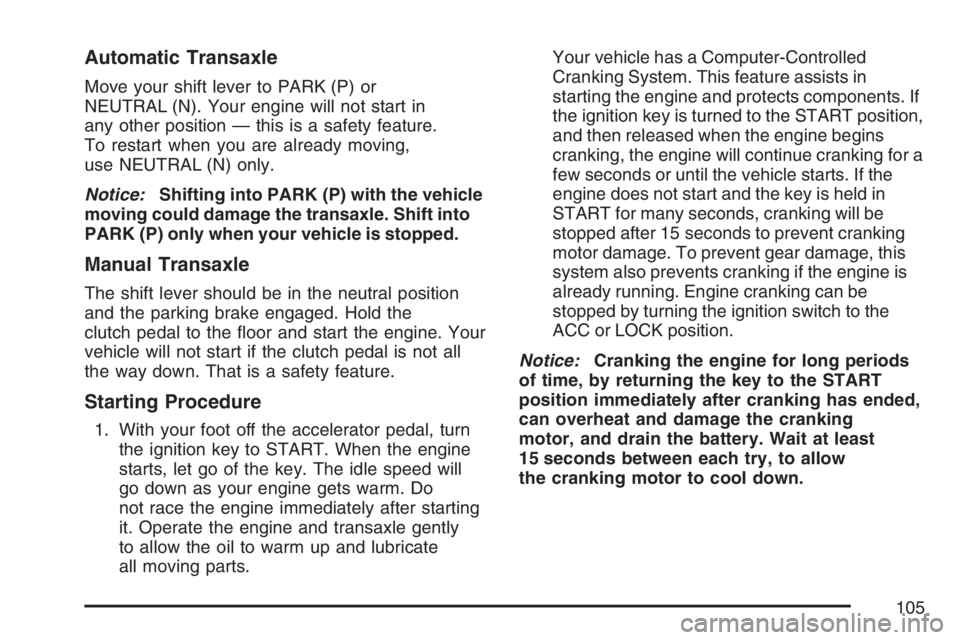
Automatic Transaxle
Move your shift lever to PARK (P) or
NEUTRAL (N). Your engine will not start in
any other position — this is a safety feature.
To restart when you are already moving,
use NEUTRAL (N) only.
Notice:Shifting into PARK (P) with the vehicle
moving could damage the transaxle. Shift into
PARK (P) only when your vehicle is stopped.
Manual Transaxle
The shift lever should be in the neutral position
and the parking brake engaged. Hold the
clutch pedal to the �oor and start the engine. Your
vehicle will not start if the clutch pedal is not all
the way down. That is a safety feature.
Starting Procedure
1. With your foot off the accelerator pedal, turn
the ignition key to START. When the engine
starts, let go of the key. The idle speed will
go down as your engine gets warm. Do
not race the engine immediately after starting
it. Operate the engine and transaxle gently
to allow the oil to warm up and lubricate
all moving parts.Your vehicle has a Computer-Controlled
Cranking System. This feature assists in
starting the engine and protects components. If
the ignition key is turned to the START position,
and then released when the engine begins
cranking, the engine will continue cranking for a
few seconds or until the vehicle starts. If the
engine does not start and the key is held in
START for many seconds, cranking will be
stopped after 15 seconds to prevent cranking
motor damage. To prevent gear damage, this
system also prevents cranking if the engine is
already running. Engine cranking can be
stopped by turning the ignition switch to the
ACC or LOCK position.
Notice:Cranking the engine for long periods
of time, by returning the key to the START
position immediately after cranking has ended,
can overheat and damage the cranking
motor, and drain the battery. Wait at least
15 seconds between each try, to allow
the cranking motor to cool down.
105
Page 108 of 432

Automatic Transaxle Operation
There are several
different positions for
your shift lever.
PARK (P):This position locks your front wheels. It
is the best position to use when you start your
engine because your vehicle cannot move easily.
{CAUTION:
It is dangerous to get out of your vehicle
if the shift lever is not fully in PARK (P)
with the parking brake �rmly set. Your
vehicle can roll.
CAUTION: (Continued)
CAUTION: (Continued)
Do not leave your vehicle when the engine
is running unless you have to. If you have
left the engine running, the vehicle can
move suddenly. You or others could be
injured. To be sure your vehicle will not
move, even when you are on fairly level
ground, always set your parking brake
and move the shift lever to PARK (P). See
Shifting Into Park (P) (Automatic
Transaxle) on page 115. If you are pulling
a trailer, seeTowing a Trailer on page 261.
Make sure that the shift lever is fully in PARK (P)
before starting the engine.
108
Page 110 of 432
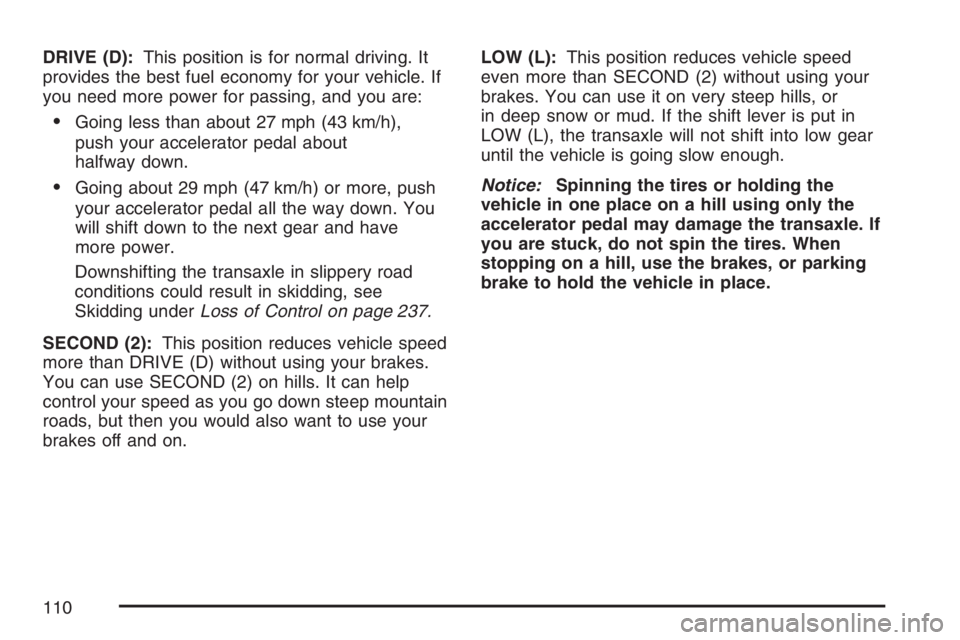
DRIVE (D):This position is for normal driving. It
provides the best fuel economy for your vehicle. If
you need more power for passing, and you are:
Going less than about 27 mph (43 km/h),
push your accelerator pedal about
halfway down.
Going about 29 mph (47 km/h) or more, push
your accelerator pedal all the way down. You
will shift down to the next gear and have
more power.
Downshifting the transaxle in slippery road
conditions could result in skidding, see
Skidding underLoss of Control on page 237.
SECOND (2):This position reduces vehicle speed
more than DRIVE (D) without using your brakes.
You can use SECOND (2) on hills. It can help
control your speed as you go down steep mountain
roads, but then you would also want to use your
brakes off and on.LOW (L):This position reduces vehicle speed
even more than SECOND (2) without using your
brakes. You can use it on very steep hills, or
in deep snow or mud. If the shift lever is put in
LOW (L), the transaxle will not shift into low gear
until the vehicle is going slow enough.
Notice:Spinning the tires or holding the
vehicle in one place on a hill using only the
accelerator pedal may damage the transaxle. If
you are stuck, do not spin the tires. When
stopping on a hill, use the brakes, or parking
brake to hold the vehicle in place.
110
Page 112 of 432
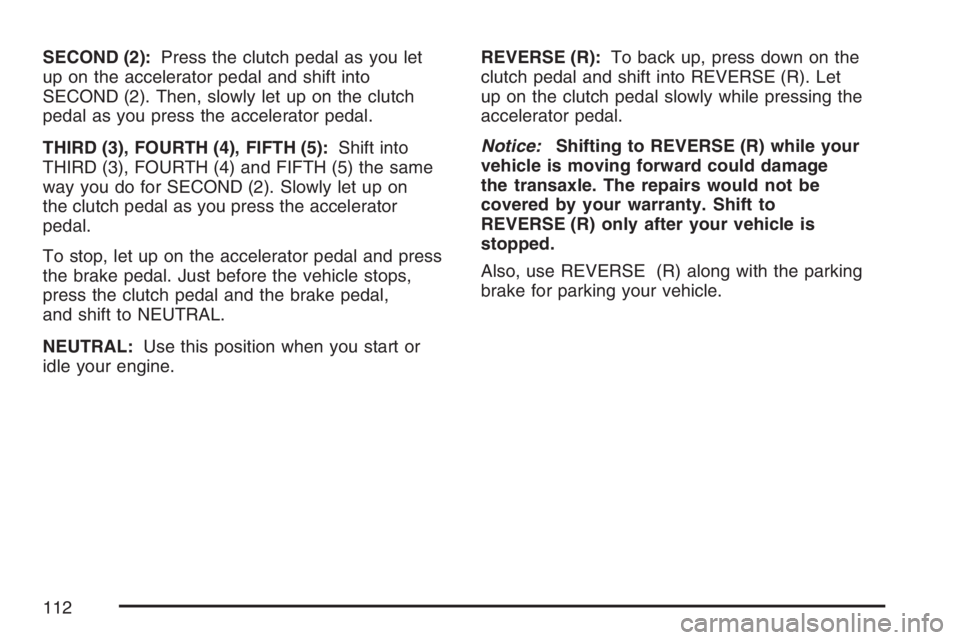
SECOND (2):Press the clutch pedal as you let
up on the accelerator pedal and shift into
SECOND (2). Then, slowly let up on the clutch
pedal as you press the accelerator pedal.
THIRD (3), FOURTH (4), FIFTH (5):Shift into
THIRD (3), FOURTH (4) and FIFTH (5) the same
way you do for SECOND (2). Slowly let up on
the clutch pedal as you press the accelerator
pedal.
To stop, let up on the accelerator pedal and press
the brake pedal. Just before the vehicle stops,
press the clutch pedal and the brake pedal,
and shift to NEUTRAL.
NEUTRAL:Use this position when you start or
idle your engine.REVERSE (R):To back up, press down on the
clutch pedal and shift into REVERSE (R). Let
up on the clutch pedal slowly while pressing the
accelerator pedal.
Notice:Shifting to REVERSE (R) while your
vehicle is moving forward could damage
the transaxle. The repairs would not be
covered by your warranty. Shift to
REVERSE (R) only after your vehicle is
stopped.
Also, use REVERSE (R) along with the parking
brake for parking your vehicle.
112
Page 114 of 432
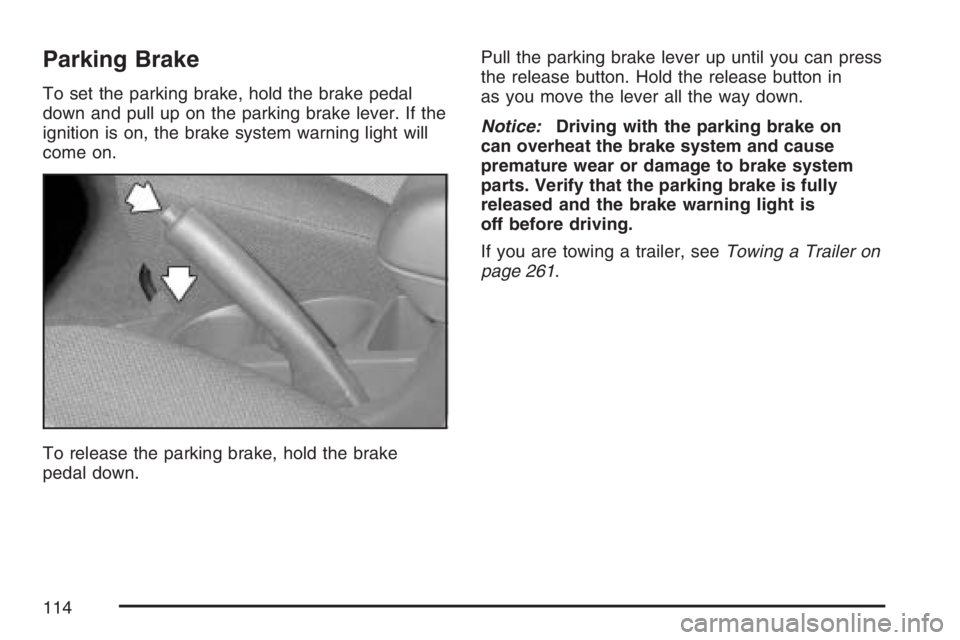
Parking Brake
To set the parking brake, hold the brake pedal
down and pull up on the parking brake lever. If the
ignition is on, the brake system warning light will
come on.
To release the parking brake, hold the brake
pedal down.Pull the parking brake lever up until you can press
the release button. Hold the release button in
as you move the lever all the way down.
Notice:Driving with the parking brake on
can overheat the brake system and cause
premature wear or damage to brake system
parts. Verify that the parking brake is fully
released and the brake warning light is
off before driving.
If you are towing a trailer, seeTowing a Trailer on
page 261.
114
Page 115 of 432
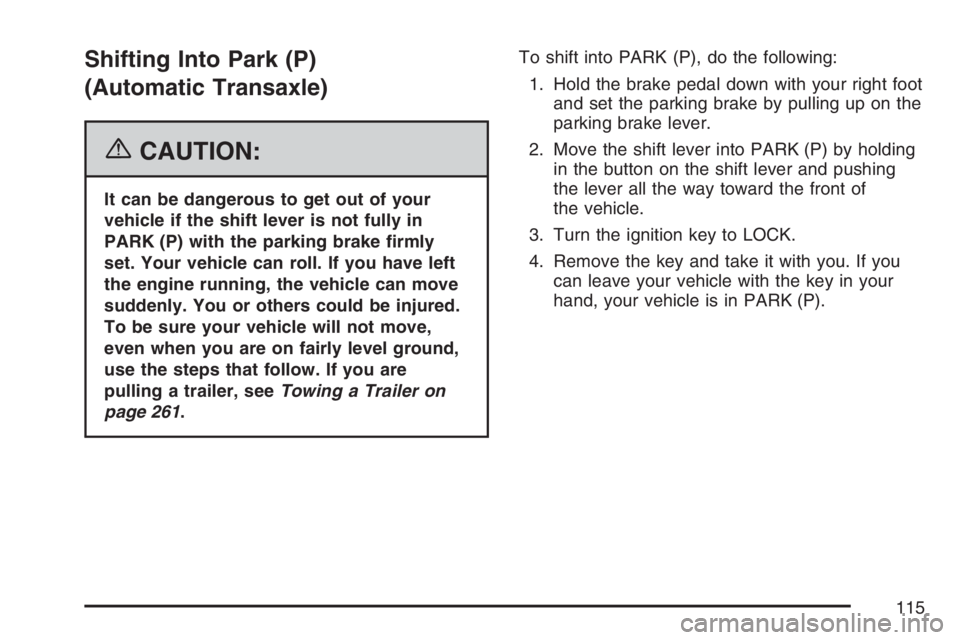
Shifting Into Park (P)
(Automatic Transaxle)
{CAUTION:
It can be dangerous to get out of your
vehicle if the shift lever is not fully in
PARK (P) with the parking brake �rmly
set. Your vehicle can roll. If you have left
the engine running, the vehicle can move
suddenly. You or others could be injured.
To be sure your vehicle will not move,
even when you are on fairly level ground,
use the steps that follow. If you are
pulling a trailer, seeTowing a Trailer on
page 261.To shift into PARK (P), do the following:
1. Hold the brake pedal down with your right foot
and set the parking brake by pulling up on the
parking brake lever.
2. Move the shift lever into PARK (P) by holding
in the button on the shift lever and pushing
the lever all the way toward the front of
the vehicle.
3. Turn the ignition key to LOCK.
4. Remove the key and take it with you. If you
can leave your vehicle with the key in your
hand, your vehicle is in PARK (P).
115
Page 116 of 432

Leaving Your Vehicle With the Engine
Running (Automatic Transaxle)
{CAUTION:
It can be dangerous to leave your vehicle
with the engine running. Your vehicle
could move suddenly if the shift lever is
not fully in PARK (P) with the parking
brake �rmly set. And, if you leave the
vehicle with the engine running, it could
overheat and even catch �re. You or
others could be injured. Do not leave your
vehicle with the engine running.
If you have to leave your automatic transaxle
vehicle with the engine running, be sure your
vehicle is in PARK (P) and your parking brake is
�rmly set before you leave it. After you have moved
the shift lever into PARK (P), hold the regular brake
pedal down. Then, see if you can move the shift
lever away from PARK (P) without �rst pulling it
toward you. If you can, it means that the shift lever
was not fully locked into PARK (P).
Torque Lock (Automatic Transaxle)
If you are parking on a hill and you do not shift into
PARK (P) properly, the weight of the vehicle
may put too much force on the parking pawl in the
transaxle. You may �nd it difficult to pull the
shift lever out of PARK (P). This is called “torque
lock.” To prevent torque lock, set the parking
brake and then shift into PARK (P) properly before
you leave the driver’s seat. To �nd out how, see
Shifting Into Park (P) (Automatic Transaxle)
on page 115.
When you are ready to drive, move the shift lever
out of PARK (P) before you release the parking
brake.
If torque lock does occur, you may need to have
another vehicle push yours a little uphill to
take some of the pressure from the parking pawl
in the transaxle, so you can pull the shift lever
out of PARK (P).
116
Page 117 of 432
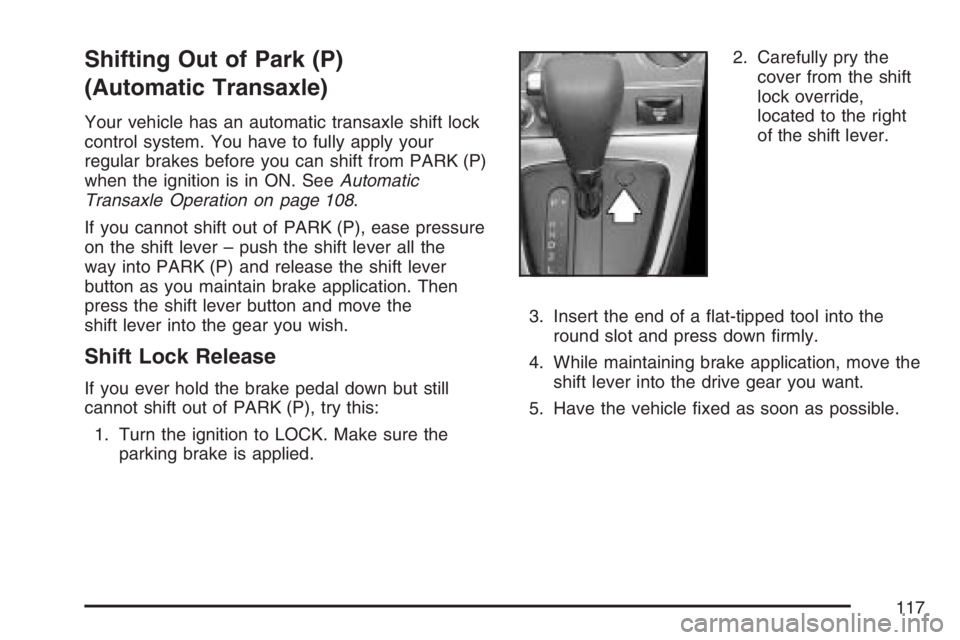
Shifting Out of Park (P)
(Automatic Transaxle)
Your vehicle has an automatic transaxle shift lock
control system. You have to fully apply your
regular brakes before you can shift from PARK (P)
when the ignition is in ON. SeeAutomatic
Transaxle Operation on page 108.
If you cannot shift out of PARK (P), ease pressure
on the shift lever – push the shift lever all the
way into PARK (P) and release the shift lever
button as you maintain brake application. Then
press the shift lever button and move the
shift lever into the gear you wish.
Shift Lock Release
If you ever hold the brake pedal down but still
cannot shift out of PARK (P), try this:
1. Turn the ignition to LOCK. Make sure the
parking brake is applied.2. Carefully pry the
cover from the shift
lock override,
located to the right
of the shift lever.
3. Insert the end of a �at-tipped tool into the
round slot and press down �rmly.
4. While maintaining brake application, move the
shift lever into the drive gear you want.
5. Have the vehicle �xed as soon as possible.
117
Page 118 of 432

Parking Your Vehicle
(Manual Transaxle)
Before you get out of your vehicle, move the shift
lever into REVERSE (R), and �rmly apply the
parking brake. Once the shift lever has been
placed into REVERSE (R) with the clutch pedal
pressed in, you can turn the ignition key to LOCK,
remove the key and release the clutch.
If you are parking on a hill, or if your vehicle is
pulling a trailer, seeTowing a Trailer on page 261.
Evaporation Pump
Your vehicle is equipped with a vacuum pump for
the vehicle’s fuel evaporation system. This
pump performs a fuel evaporation leakage test
approximately �ve hours after the engine is turned
off. You may hear a sound coming from
underneath the rear cargo compartment for
several minutes.
The noise is normal and does not signify a
malfunction. See your dealer with any questions.
Parking Over Things That Burn
{CAUTION:
Things that can burn could touch hot
exhaust parts under your vehicle and
ignite. Do not park over papers, leaves,
dry grass, or other things that can burn.
118